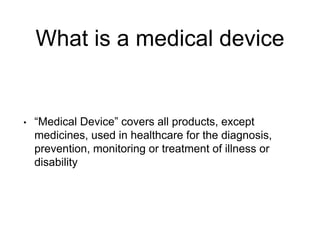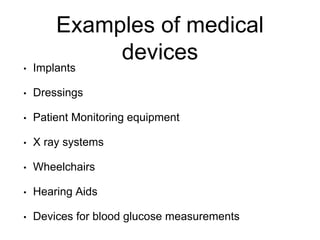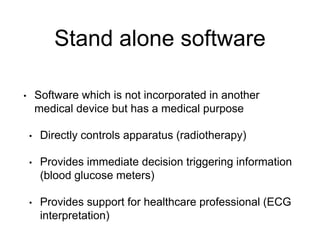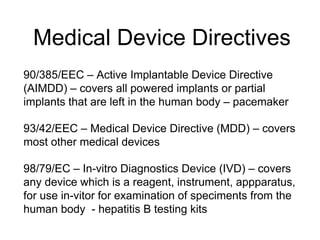medical devices for the safety standards and codes
- 1. Medical Devices Department of Engineering February 11th 2015
- 2. Medical Devices • What is a medical device • Approvals required for studies involving medical devices • Who and how are they regulated
- 3. What is a medical device • “Medical Device” covers all products, except medicines, used in healthcare for the diagnosis, prevention, monitoring or treatment of illness or disability
- 4. Examples of medical devices • Implants • Dressings • Patient Monitoring equipment • X ray systems • Wheelchairs • Hearing Aids • Devices for blood glucose measurements
- 5. Examples of products that can be both a medical device and non medical device • Personal protective equipment • Who are you protecting? • what is the principal stated purpose of the product by the manufacturer? • Rubber/latex gloves • Marigolds = general purpose so not medical device • surgical gloves = medical device
- 6. Stand alone software • Software which is not incorporated in another medical device but has a medical purpose • Directly controls apparatus (radiotherapy) • Provides immediate decision triggering information (blood glucose meters) • Provides support for healthcare professional (ECG interpretation)
- 7. Decision tree for standalone software • Is it a computer programme? • Does the programme perform an action on data? • Is it for the benefit of an individual patient - will it evaluate patient data to support or influence the medical care provided to that patient?
- 8. • Words associated with a medical device • amplify, analysis, interpret, alarms, calculates, controls, converts, detects, diagnose, measures, monitors • Software that applies some sort of automated reasoning - calculation, dose calculation, algorithm, clinicians guide APPs as medical devices
- 9. • Software that provides personalised guidance • makes use of information entered by the patients, provided by point of care devices or obtained via health records, if it affects the treatment of the patient • If the software performs a calculation or interprets data and the healthcare provider does not review the raw data = medical device
- 10. Intention to “place on market” Research with the intention to “commercialise” the device or “place on the market” – make available in return for payment or free of charge, with a view to distribution, use or both Requires MHRA approval
- 11. Manufacturer Person responsible for the design, manufacture, packaging and labelling of a device before it is placed on the market
- 12. In house manufacture • No intention to “put on the market” or place into service under the manufacturer’s name • There is no transfer of ownership of the product or intention to give to another NHS Trust • Not covered by medical device regulations but may be covered by general research requirements if used in a hospital • Any data gathered cannot be used in a future MHRA submission
- 13. Working with Addenbrooke’s If the Chief Investigator is an Addenbrooke’s employee or a researcher based at the Clinical School then this MAY be considered “in house” manufacture R&D approval Clinical Engineering approval Electronic safety standards must be met Evidence of liability cover
- 14. Research in a clinical setting Any study recruiting participants from the NHS, using patient data or patient tissue requires NRES ethics approval and R&D approval Any study using NHS facilities in a study requires R&D approval Any study using NHS staff as participants in a study requires R&D approval and University ethics approval
- 15. Research with patients • Sponsorship • Confirmation of Funding • Appropriate peer review • Favourable ethical opinion letter • Confirmation of insurance for your study • Confirmation of honorary research contracts • Appropriate agreements with third parties
- 16. Research Ethics Proof of concept studies recruiting a small number of healthy volunteers – internal ethics approval - but considered on a case by case basis. Studies recruiting a large group of healthy volunteers - no longer a proof of concept study – MHRA assumption that there is an intention to commercialise or “put on market” – NRES ethics approval and MHRA approval Clinical Investigation studies of medical device – NRES ethics approval and may require MHRA approval
- 17. Insurance Whatever the setting, if you are using a medical device in any type of research, it is important to ensure that appropriate insurance is in place Insurance contact: Victoria Hollamby Victoria.Hollamby@admin.cam.ac.uk
- 18. Medical devices and regulation • Devices are categorised into classes according to the degree of risk inherent in the device • Class I - low risk – apps, standalone software • Class 11a and 11b – medium risk • Class III high risk • The conformity assessment and the CE mark depend on the Class of the product
- 19. Classification Depends upon a series of factors including: How long the device is intended to be in continuous use Whether or not the device is invasive Whether the device is implantable or active Whether or not the device contains a substance
- 20. Non invasive device Class I - In contact with injured skin – provide mechanical barrier, eg plasters, wound gauze Class IIa - Intended to manage micro-environment of wound – control moisture at wound, eg hydrogel dressings. Not for extensive wounds Class IIb - Intended for wounds which breach dermis and heal only by secondary intent – severe burns eg temporary skin substitute
- 21. Class I If you are satisfied that your medical device complies with the requirements in the MDD, you must write a statement to declare this – “Declaration of Conformity” As 11th February 2015 new online application system for Class I devices, (Device Online Registration System, DORS) .
- 22. Class IIa and IIb Safety and performance needs to be adequately demonstrated – may need clinical investigation if insufficient existing clinical data
- 23. Devices requiring clinical investigation Device is implantable or Class III medical device Introducing new concept of device into medical practice Existing device modified so a novel feature may have important phsyiological effects or it affects clinical performance and safety of the device
- 24. Devices requiring clinical investigation Devices incorporating materials previously untested in humans Device, either CE marked or non CE marked, being proposed for a new purpose or function In vitro and/or animal testing of device cannot mimic the clinical situation New manufacturer, especially of a high risk device
- 25. Medical Device Directives 90/385/EEC – Active Implantable Device Directive (AIMDD) – covers all powered implants or partial implants that are left in the human body – pacemaker 93/42/EEC – Medical Device Directive (MDD) – covers most other medical devices 98/79/EC – In-vitro Diagnostics Device (IVD) – covers any device which is a reagent, instrument, appparatus, for use in-vitor for examination of speciments from the human body - hepatitis B testing kits
- 26. Organisations Competent Authority – MHRA Notified Body – CE Marking Ethics – Health Research Authority NRES NHS - R&D
- 27. MHRA Ensures compliance with regulations Evaluates adverse incident reports Pre-clinical assessment of devices intended for clinical trial Designates the independent certification organisation (notified bodies)
- 28. Notified Bodies Check manufacturers of medium and high risk devices have followed the requirement Issue CE marks for these devices
- 29. Useful contacts Research Governance Officer – Carolyn Read cad50@medschl.cam.ac.uk 01223 769291 Research Governance Manager Addenbrooke’s Hospital – Louise Stockley louise.stockley@addenbrookes.nhs.uk






























